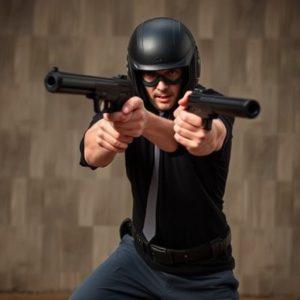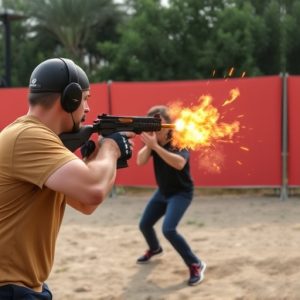Mastering Stun Gun Safety: Preventing Accidental Discharges
Accidental discharges from stun guns pose significant risks, primarily due to user error. To mitigat…….
Accidental discharges from stun guns pose significant risks, primarily due to user error. To mitigate this, manufacturers should integrate robust safety features like locking mechanisms and smart sensors, alongside clear user manuals and training. Key components for effective accidental discharge prevention include mechanical triggers, advanced microprocessors, high-quality construction, and smart sensors. Recent technological advancements have led to safer stun guns with innovative design elements, such as two-step activation processes and multiple safety switches. Hands-on testing is vital to ensure these features operate accurately, while regulatory standards mandate safety measures like robust safety switches and impact resistance. Comprehensive user education complements these features, enabling individuals to use stun guns effectively for self-defense while minimizing risks of accidental discharges.
Accidental discharge of stun guns can lead to severe consequences, underscoring the need for robust prevention mechanisms. This article delves into the critical aspects of accidental discharge—causes, risks, and preventive measures. We explore key components of effective systems, highlighting advancements in technology that enhance stun gun safety features. Through hands-on testing, we evaluate these mechanisms, emphasizing the importance of regulatory standards and user education as vital layers of protection. Discover the best safety features designed to safeguard users and mitigate risks associated with stun guns.
- Understanding Accidental Discharge: Causes and Risks
- Key Components of Effective Prevention Mechanisms
- Advanced Technology in Stun Gun Safety Features
- Hands-on Testing: Evaluating Prevention Mechanisms
- Regulatory Standards and Their Role in Safety
- User Education: A Crucial Layer of Protection
Understanding Accidental Discharge: Causes and Risks
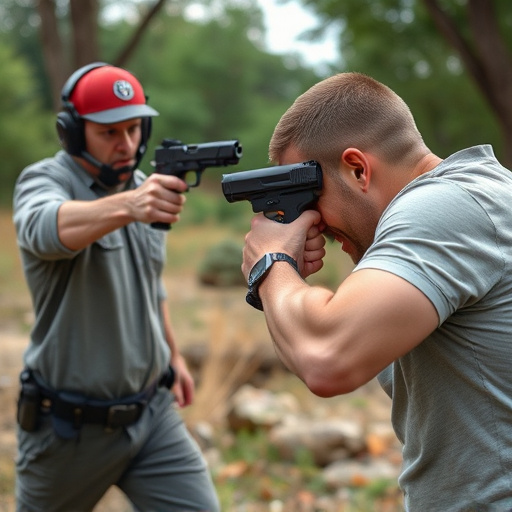
Accidental discharge, an unwanted and potentially dangerous event, is a significant concern when it comes to stun guns or any self-defense device. Understanding the causes and risks associated with these incidents is paramount in developing effective prevention mechanisms. One of the primary factors contributing to accidental discharges is user error, including incorrect handling, failure to follow safety procedures, or misunderstanding the device’s activation mechanism.
The best safety features in stun guns play a crucial role in mitigating these risks. These include mechanical safeguards like locking mechanisms that prevent accidental activation and smart sensors that detect body contact for safe use. Additionally, clear and concise user manuals, emphasizing proper handling and deactivation procedures, are essential. By combining robust safety features with comprehensive training, users can effectively reduce the likelihood of accidental discharges, enhancing their personal safety and the reliability of the stun gun as a defensive tool.
Key Components of Effective Prevention Mechanisms
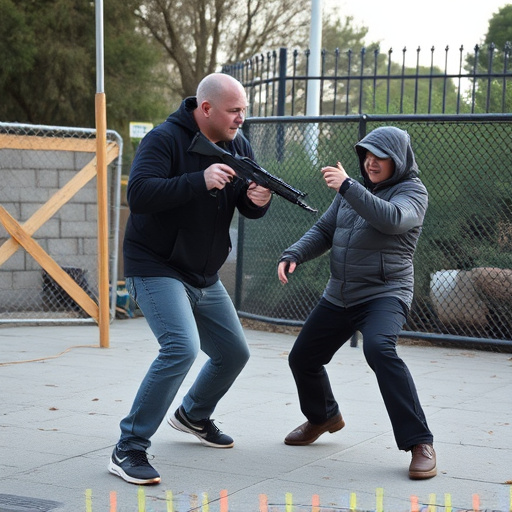
The effectiveness of accidental discharge prevention mechanisms in stun guns hinges on several key components, each playing a vital role in ensuring user safety. Primarily, these include mechanical triggers that demand deliberate action to activate the device, often requiring both pressure and a specific motion. This dual-action design significantly reduces the risk of unintended deployment, as it takes more than just a bump or a fall to set off the stun gun. Additionally, advanced microprocessors with sophisticated algorithms can detect and prevent discharges in various scenarios, ensuring that the weapon only activates under controlled conditions.
Furthermore, high-quality construction using durable materials is essential for reliable prevention mechanisms. A robust outer casing protects internal components from impact and moisture, minimizing potential malfunctions. Integrating smart sensors capable of detecting user intent and environmental factors also contributes to overall safety. These features work in tandem with clear, intuitive instructions and safety guidelines, empowering users to understand and utilize the best safety features in stun guns effectively, thereby enhancing personal security without compromising control.
Advanced Technology in Stun Gun Safety Features
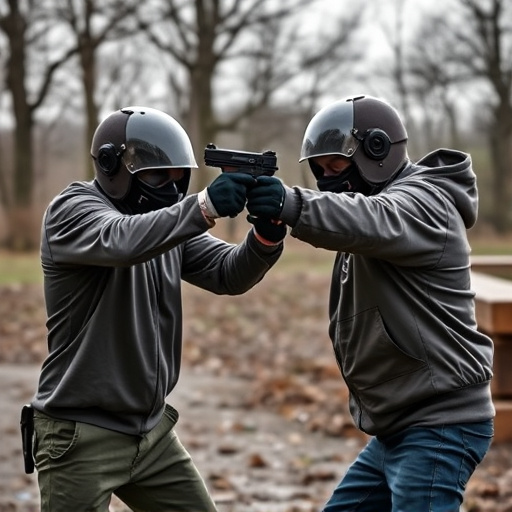
In recent years, advancements in technology have led to the development of more sophisticated and safer stun guns, equipping users with powerful yet controlled protection. The best safety features in stun guns now incorporate innovative design elements that reduce accidental discharge risks while enhancing overall usability. One prominent feature is the addition of advanced sensors and microprocessors, which enable the device to detect body movement and proximity, ensuring activation only when intended. These smart safety mechanisms significantly minimize the chances of accidental activation during storage or transportation, making them ideal for personal protection.
Furthermore, modern stun guns often incorporate multiple safety switches and locking systems. Some models feature a two-step activation process, requiring both a press and a twist of the device to deliver a shock, adding an extra layer of control. Locking mechanisms that prevent accidental deployment when not in use are also standard across many premium brands. These advanced safety features not only protect users from unintended shocks but also give them peace of mind, ensuring their stun gun remains a reliable tool for self-defense when needed.
Hands-on Testing: Evaluating Prevention Mechanisms
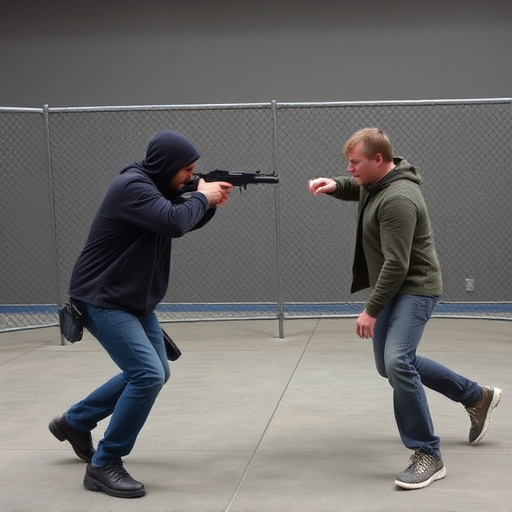
Hands-on testing is an essential step in evaluating the effectiveness and reliability of accidental discharge prevention mechanisms in stun guns. This process involves simulating real-world scenarios to ensure that the device operates as intended, with minimal risk of unintended activation. By subjecting these safety features to rigorous hands-on evaluation, users can gain valuable insights into their performance under various conditions.
The best safety features in stun guns should demonstrate a high degree of responsiveness and accuracy during testing. For instance, a successful prevention mechanism should instantly deactivate the device upon detecting an unintended touch or movement, preventing any unexpected discharges. This ensures that even in the event of accidental contact, the user remains protected. Hands-on testing also helps identify any potential weaknesses or false triggers, allowing manufacturers to refine their design and provide users with the highest level of safety possible.
Regulatory Standards and Their Role in Safety
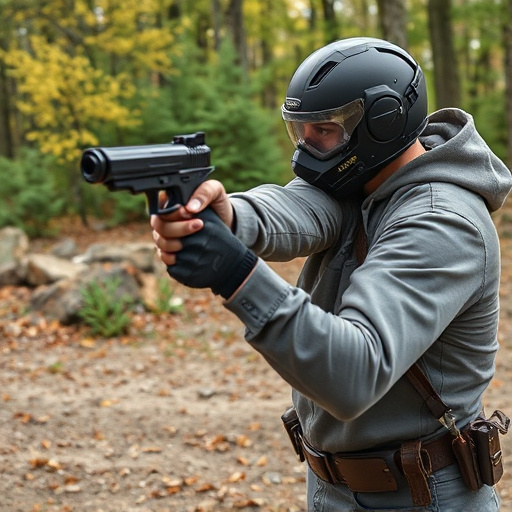
In the realm of self-defense and safety, regulatory standards play a pivotal role in ensuring the development and deployment of reliable tools like stun guns. These standards act as a beacon, guiding manufacturers to incorporate the best safety features in stun guns, thereby minimizing accidental discharges. Organizations worldwide set guidelines that dictate design, testing, and quality control processes, guaranteeing the devices’ safety for intended users while mitigating risks.
The integration of these standards into production ensures that stun guns undergo rigorous evaluations to prevent unintended activations. Features such as robust safety switches, smart triggering mechanisms, and advanced impact resistance are not only mandated but also celebrated as integral parts of the best safety features in stun guns. This commitment to safety is a testament to how regulatory bodies drive innovation, fostering the development of more secure and reliable personal defense tools for citizens worldwide.
User Education: A Crucial Layer of Protection
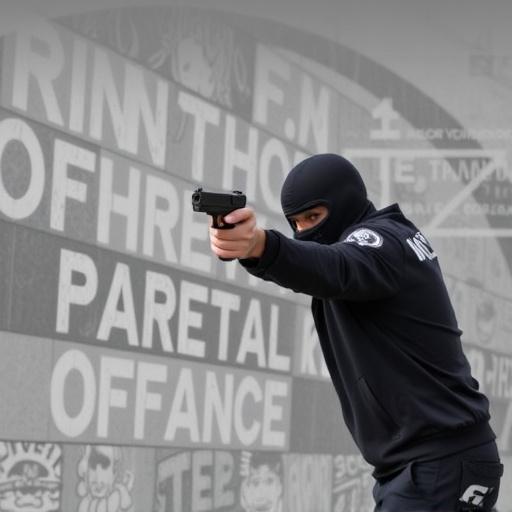
User education plays a pivotal role in accidental discharge prevention, especially with stun guns and similar self-defense devices. Understanding how to safely operate such tools is fundamental, as misuse can lead to unintentional activation and potential harm. Many modern stun guns come equipped with advanced safety features, like smart triggers that require intentional pressure for activation, minimizing the risk of accidental discharges. Additionally, thorough training on target acquisition, de-escalation techniques, and proper handling ensures users know when and how to deploy the device effectively while mitigating risks.
Educational programs often include demonstrations and practice sessions, empowering individuals to make informed decisions in stressful situations. By combining these best safety features with user education, individuals can confidently utilize stun guns as a last resort for self-defense without compromising their safety or facing legal repercussions due to accidental discharges.
Accidental discharge is a serious concern, but with the right prevention mechanisms, it can be significantly mitigated. By understanding the causes and risks, incorporating advanced technology, adhering to regulatory standards, and educating users, we can ensure that stun guns offer the best safety features available. Hands-on testing further validates these mechanisms, ensuring users receive reliable protection. User education remains a crucial layer of protection, empowering individuals to use their stun guns responsibly and safely.

